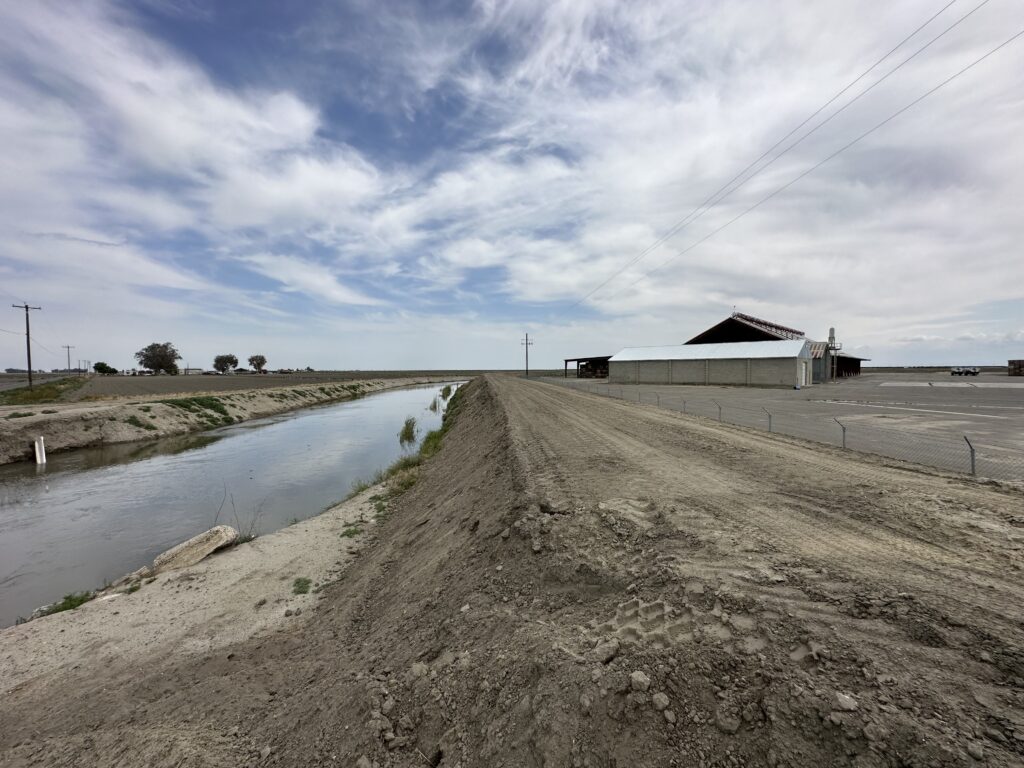Growers and water managers in the Tulare Lake area have been moving mountains of dirt to beef up levees and build entirely new ones as they brace for snowmelt this summer.
A string of storms in March battered the region, blowing out levees and overwhelming infrastructure as flood water plowed through homes, dairies and crops. The mad scramble to move dirt is in part to repair that damage but also to fend off future damage in the face of an historic snowpack that’s already swelling valley rivers.
“It’s turning into ‘Whoever has the biggest berm wins,’” said Craig Andrew, manager for Sandridge Partners, one of the largest landowners in Kings County.
Sandridge built a large berm around its raisin facility about a mile southeast of the tiny community of Stratford on Highway 41, he said. Other farmers are taking dirt from Sandridge to build berms around their farms and dairies.
Berms are going up all around the Stratford area as locals fret about the South Fork of the Kings River potentially going above its current flow of 2,500 cubic feet per second. In fact, water is already standing against the levees that protect Stratford.
Growers are spending, “millions of dollars,” building berms to protect themselves, confirmed Mark Grewal, a water manager in Kings County.
“These levees are gigantic,” said Grewal. “They’re million dollar plus levees.”
It’s mostly private companies and landowners doing the levee building, he said.
Vahid Salehi has been building up levees to try and hold off increasing flows from the Kings River. Salehi is the president of Pistacia Global, which manages about 8,500 acres of almonds and pistachios throughout Kings, Tulare and Fresno counties.
The problem areas have mostly been on properties next to the North Fork Kings River, said Salehi. There, multiple sections of crops have been inundated with water. Salehi and his workers have been excavating and moving dirt so they can bring in pumps to redirect the water.
While it hasn’t cost the company millions, it’s still expensive, said Salehi. He estimates costs from roughly the last month of labor and equipment at about $50,000.
“There’s a lot of issues and maybe budget-wise infrastructure problems,” said Salehi. “There’s just all sorts of problems.”
Pistacia Global’s Kings River properties are within the jurisdiction of the Kings River Conservation District, which oversees river infrastructure and flood operations, among other things.
For the most part, Salehi is able to do what he wants when it comes to moving dirt. But there have been some instances where KRCD has stopped construction, he said.
Salehi was moving dirt on the river trying to build up some of the lower parts of the banks when KRCD told him to stop. The construction would put pressure on other parts of the river, KRCD staff told him.
“We have a good relationship with them, we try to be friends with everybody. So we haven’t tried to challenge it so much,” said Salehi. “The river has its own rules and they try to enforce those rules.”
KRCD staff have also been moving dirt building up levees. The district manages 140 miles of levees on the Kings River that start upstream of Highway 43 and run through the main river channel, the North Fork and the South Fork down to the town of Stratford.
Landowners are allowed to do what they want on their own property, said Charlotte Gallock, director of water resources and chief engineer for KRCD. But the district has jurisdiction on anything within 15 feet of the river levee, she said. Any work in those areas needs to be coordinated with the district and permitted by the Central Valley Flood Protection Board, she said.
There are three locations where levees have been sloughing dirt and have had to be rebuilt, said Gallock. Two were on the main river channel near Lemoore and the third was on the South Fork, she said.
The biggest area of concern is the South Fork, said Gallock. The district has already raised some sections of levees, in one area by about three feet and another by a foot. There will probably be more levee raising to follow.
“We’re moving forward with those projects in those areas of concern and we anticipate those will be done pretty swiftly,” said Gallock.
Kings County and the Office of Emergency Services have helped to get levee building materials down to the district, she said.
KRCD has seven workers patrolling the levee system during the day and eight patrolling at night. It’s a 24 hour surveillance system, said Gallock.
“They’ll look to see if there’s water somewhere where it shouldn’t be,” said Gallock.
The berm building frenzy has sometimes run afoul of Kings County rules.
“Some berms have been placed in the public right of way, we are either removing the berms if they create a safety issue or if acceptable, we work with the property owner to secure an encroachment permit,” wrote a Kings County spokesperson in an email.
Meanwhile, the Tulare Lake, once the largest freshwater lake west of the Mississippi until it was drained more than 150 years ago for agriculture, continues to refill. Flood water is creeping close to Stratford and Corcoran where it’s being held back by the Corcoran levee.
The state is paying $17 million to raise that levee.
But managers at Westlake Farms five miles south of Stratford are taking matters into their own hands. The company hasn’t taken any water yet but workers are building a levee around its headquarters, said Ceil Howe III, COO of Westlake Farms.
The company owns about 2,000 acres of pistachios, olives and field crops.
The levee building is, “just a precautionary practice,” said Howe III.
“We just have to take care of ourselves,” said Howe III. “It’s just tough times for everybody. It’s just unfortunate. Mother Nature wins and it’s just a tough deal.”
Share this:
- Click to share on Facebook (Opens in new window)
- Click to share on Twitter (Opens in new window)
- Click to share on LinkedIn (Opens in new window)
- Click to share on Reddit (Opens in new window)
- Click to share on Tumblr (Opens in new window)
- Click to share on Pinterest (Opens in new window)
- Click to share on Pocket (Opens in new window)
- Click to share on Telegram (Opens in new window)
- Click to share on WhatsApp (Opens in new window)
- Click to print (Opens in new window)








